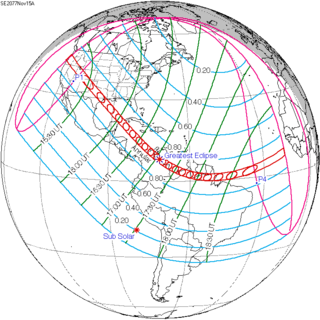
Summary
An annular solar eclipse will occur on Monday, November 15, 2077, with a magnitude of 0.9371. A solar eclipse occurs when the Moon passes between Earth and the Sun, thereby totally or partially obscuring the image of the Sun for a viewer on Earth. An annular solar eclipse occurs when the Moon's apparent diameter is smaller than the Sun's, blocking most of the Sun's light and causing the Sun to look like an annulus (ring). An annular eclipse appears as a partial eclipse over a region of the Earth thousands of kilometres wide. The path of annularity will cross North America and South America. This will be the 47th solar eclipse of Saros cycle 134. A small annular eclipse will cover only 93.71% of the Sun in a very broad path, 262 km wide at maximum, and will last 7 minutes and 54 seconds. Occurring only 4 days after apogee (Apogee on Thursday, November 11, 2077), the Moon's apparent diameter is smaller.
| Solar eclipse of November 15, 2077 | |
|---|---|
 Map | |
| Type of eclipse | |
| Nature | Annular |
| Gamma | 0.4705 |
| Magnitude | 0.9371 |
| Maximum eclipse | |
| Duration | 474 s (7 min 54 s) |
| Coordinates | 7°48′N 70°48′W / 7.8°N 70.8°W |
| Max. width of band | 262 km (163 mi) |
| Times (UTC) | |
| Greatest eclipse | 17:07:56 |
| References | |
| Saros | 134 (47 of 71) |
| Catalog # (SE5000) | 9682 |
More details about the Annular Solar Eclipse on Monday, November 15, 2077 edit
Eclipse Magnitude = 0.93707
Eclipse Obscuration = 0.87810
Gamma = 0.47047
Saros Series = 134th (47 of 71)
Greatest Eclipse = 15 Nov 2077 17:06:10.2 UTC
Ecliptic Conjunction = 15 Nov 2077 17:00:37.8 UTC
Equatorial Conjunction = 15 Nov 2077 16:46:06.0 UTC
Sun right ascension = 15.44
Sun declination = -18.8
Sun diameter (arcseconds) = 1940.2
Moon right ascension = 15.45
Moon declination = -18.4
Moon diameter (arcseconds) = 1793.8
Geocentric Libration of the Moon
Latitude: 3.3 degrees south
Longitude: 0.6 degrees west
Direction: 12.7 (NNE)
Date of this Annular Solar Eclipse: Monday, 15 November 2077
Related eclipses edit
Solar eclipses 2076–2079 edit
This eclipse is a member of a semester series. An eclipse in a semester series of solar eclipses repeats approximately every 177 days and 4 hours (a semester) at alternating nodes of the Moon's orbit.[1]
| Solar eclipse series sets from 2076 to 2079 | ||||
|---|---|---|---|---|
| Ascending node | Descending node | |||
| Saros | Map | Saros | Map | |
| 119 | June 1, 2076 Partial |
124 | November 26, 2076 Partial | |
| 129 | May 22, 2077 Total |
134 | November 15, 2077 Annular | |
| 139 | May 11, 2078 Total |
144 | November 4, 2078 Annular | |
| 149 | May 1, 2079 Total |
154 | October 24, 2079 Annular | |
Tzolkinex edit
- Preceded: Solar eclipse of October 4, 2070
- Followed: Solar eclipse of December 27, 2084
Saros 134 edit
It is a part of Saros cycle 134, repeating every 18 years, 11 days, containing 71 events. The series started with a partial solar eclipse on June 22, 1248. It contains total eclipses from October 9, 1428 through December 24, 1554 and hybrid eclipses from January 3, 1573 through June 27, 1843, and annular eclipses from July 8, 1861 through May 21, 2384. The series ends at member 71 as a partial eclipse on August 6, 2510. The longest duration of totality was 1 minutes, 30 seconds on October 9, 1428. All eclipses in this series occur at the Moon’s descending node.[2]
| Series members 32–48 occur between 1801 and 2100: | ||
|---|---|---|
| 32 | 33 | 34 |
| June 6, 1807 |
June 16, 1825 |
June 27, 1843 |
| 35 | 36 | 37 |
| July 8, 1861 |
July 19, 1879 |
July 29, 1897 |
| 38 | 39 | 40 |
| August 10, 1915 |
August 21, 1933 |
September 1, 1951 |
| 41 | 42 | 43 |
| September 11, 1969 |
September 23, 1987 |
October 3, 2005 |
| 44 | 45 | 46 |
| October 14, 2023 |
October 25, 2041 |
November 5, 2059 |
| 47 | 48 | |
| November 15, 2077 November 27, 2095 | ||
Tritos series edit
This eclipse is a part of a tritos cycle, repeating at alternating nodes every 135 synodic months (≈ 3986.63 days, or 11 years minus 1 month). Their appearance and longitude are irregular due to a lack of synchronization with the anomalistic month (period of perigee), but groupings of 3 tritos cycles (≈ 33 years minus 3 months) come close (≈ 434.044 anomalistic months), so eclipses are similar in these groupings.
| Series members between 1901 and 2100 | |||
|---|---|---|---|
| March 29, 1903 (Saros 118) |
February 25, 1914 (Saros 119) |
January 24, 1925 (Saros 120) | |
| December 25, 1935 (Saros 121) |
November 23, 1946 (Saros 122) |
October 23, 1957 (Saros 123) | |
| September 22, 1968 (Saros 124) |
August 22, 1979 (Saros 125) |
July 22, 1990 (Saros 126) | |
| June 21, 2001 (Saros 127) |
May 20, 2012 (Saros 128) |
April 20, 2023 (Saros 129) | |
| March 20, 2034 (Saros 130) |
February 16, 2045 (Saros 131) |
January 16, 2056 (Saros 132) | |
| December 17, 2066 (Saros 133) |
November 15, 2077 (Saros 134) |
October 14, 2088 (Saros 135) | |
| September 14, 2099 (Saros 136) |
|||
References edit
External links edit
- Earth visibility chart and eclipse statistics Eclipse Predictions by Fred Espenak, NASA/GSFC
- Google interactive map
- Besselian elements


